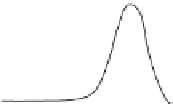Biomedical Engineering Reference
In-Depth Information
Fig. 8.3
Angular
dependence of reflection for
iridescent structures
R
q
0
a more amazing capacity of light modulation by periodic micro- and nanostructures
than butterflies. In particular, the wings of
Ancyluris meliboeus
consist of 50-m-
wide and 100-m-long overlapping scales arranged like roof tiles with a density of
500-600 scales mm
2
. Each scale is made of layers of 150-nm-thick, 200-nm-wide,
and 1:5-m-long cuticles separated by air spaces; the rows of cuticles are tilted at
30
ı
with respect to the scale substrate. These structures produce bright iridescence,
characterized by an angle-dependent reflection, as shown in Fig.
8.3
.
A nanoengineering approach to reproduce the structure and the angle-dependent
reflectivity of this butterfly wing, which involves nanoimprint lithography and shear
patterning, is described in
Kustandi et al.
(
2009
). A silicon nitride mold containing
nanosized trenches is pressed at high temperature against a polymer, which fills the
trenches under external imprint pressure. After cooling, a controlled lateral collapse
of the high-aspect-ratio polymer nanostructures obtained after releasing the mold
can be achieved by applying a horizontal force during the release process; as shown
in Fig.
8.4
, nanostructures of similar dimensions and tilting as in butterfly wings can
be achieved with polycarbonate, which is a material that has sufficient mechanical
stability to obtain periodic patterns of collapsed nanopillars, low elastic modulus at
high temperatures to fill the mold trenches, and high elongation break and tensile
strength necessary to produce uniform arrays of sheared nanostructures. In addition,
polycarbonate, as well as the chitin in the butterfly wings, is hydrophobic, which
prevents matting between neighboring pillars and maintains the air gaps between
nanostructures. The sheared pillars do not fracture from the substrate, but arrange
as shown in Fig.
8.4
, where the separation of adjacent pillars varies gradually, the
observed colors, color intensity, and color patterns of the structure varying in a broad
range. The structure is periodic, acting as a grating while producing interference
and scattering for illumination normal to the substrate due to the inclination of the
pillars. Rainbow patterns appear for incident light normal to the ridge lines, and
dominant colors are observed for other light directions. Unlike in butterfly wings,
rainbow patterns in multiple directions could be observed in the synthetic structure
if the polymer pillars are pulled from the mold in several steps, each with a different
pulling direction.
Structures that simulate the color mixing effect of the
Papilio blumei
wings have
been described in
Kolle et al.
(
2010
). The color of these butterfly wings results from
juxtaposing yellow-green and blue colors obtained by light reflection on the centers
and edges of concavities on wing scales, respectively. These concavities have widths
of 5-10m and are clad with a multilayer perforated cuticle, which reflects light
at 525 nm at normal incidence and at 477 nm at 45
ı
incidence. In addition, light




Search WWH ::

Custom Search